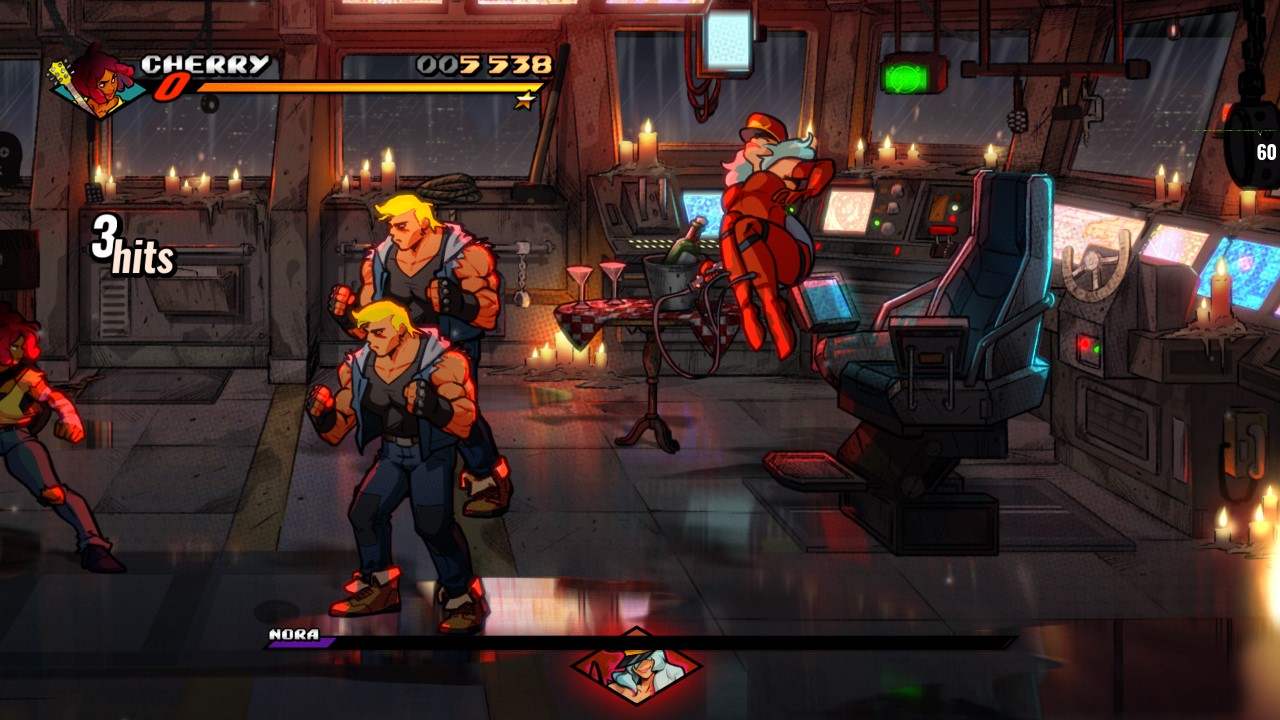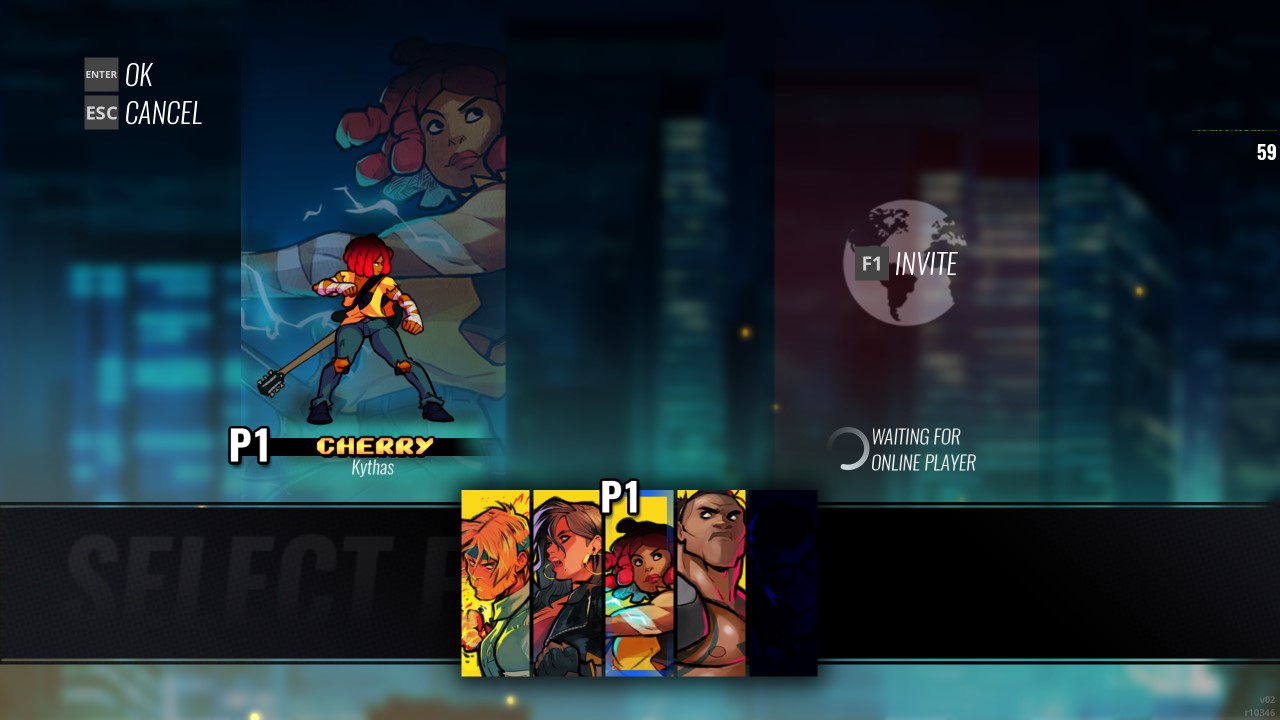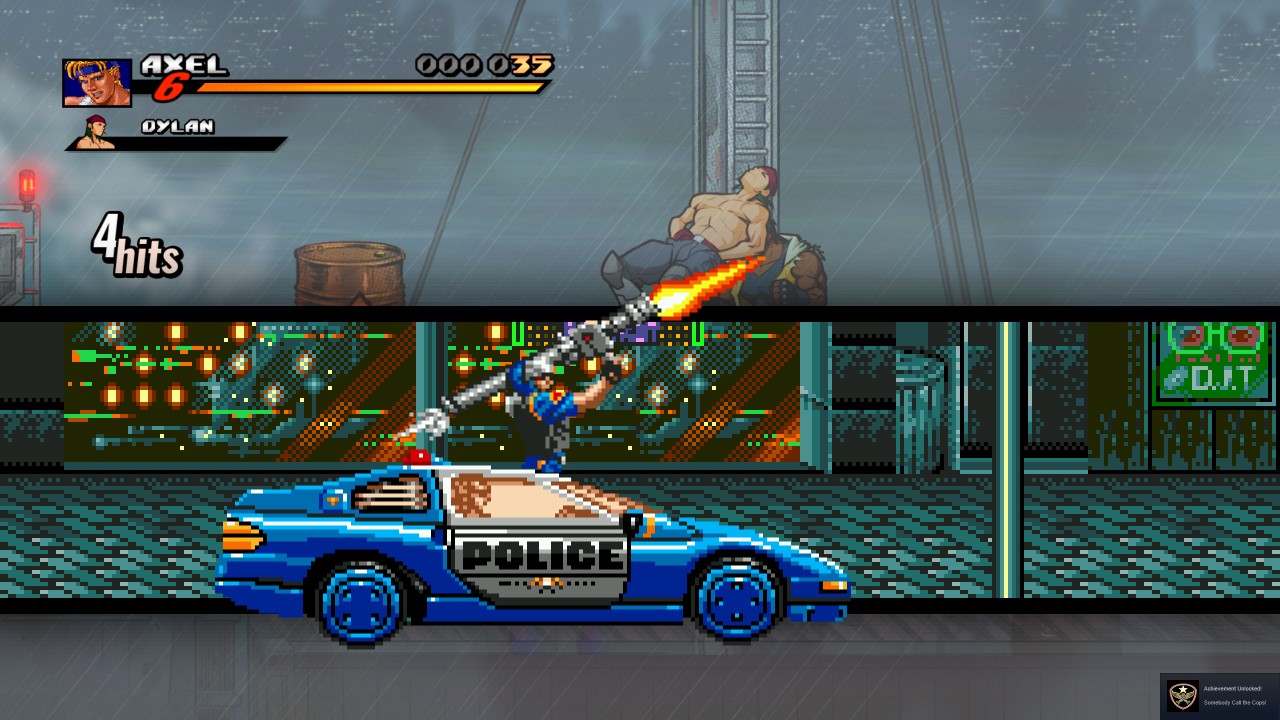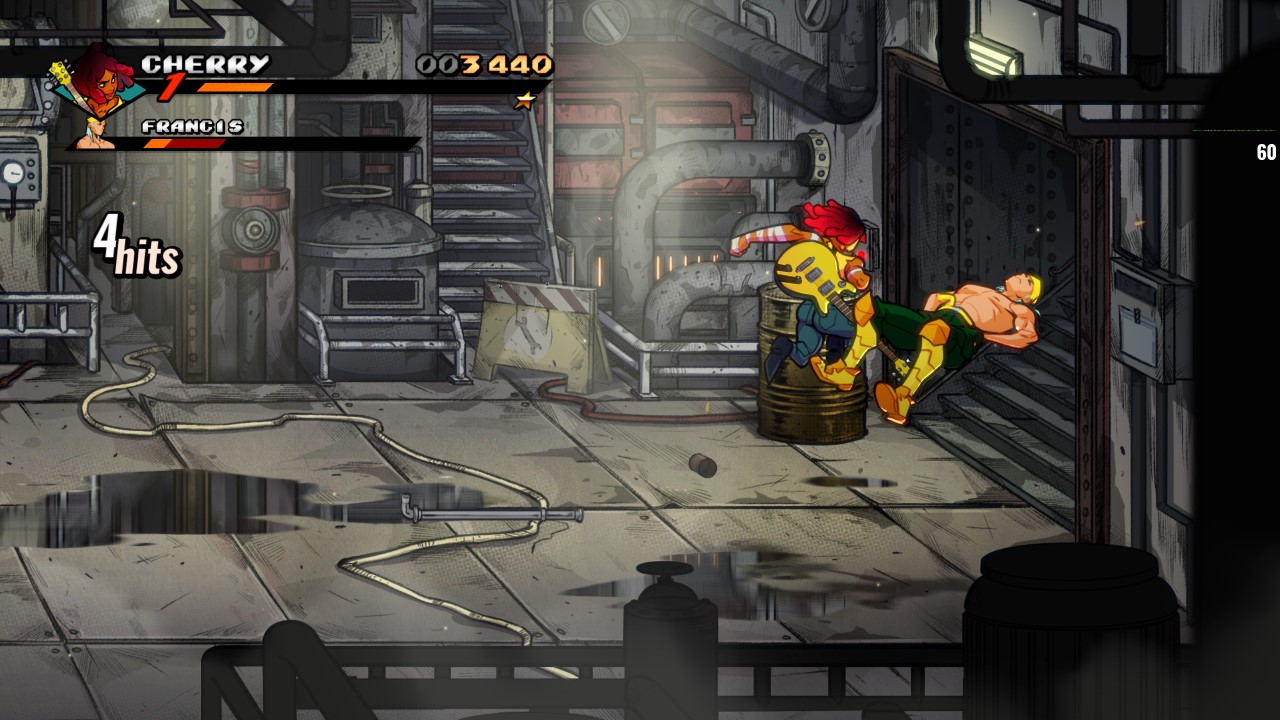Streets of Rage 4 is a bit of a time-capsule. It may have the veneer of a modern title, but its soul remains firmly planted in the early 90s. It’s doesn’t try and alter the established formula, instead opting for refinement over evolution. For returning fans this will be a godsend; for new players an annoyance. Where you’ll land on that divide will be determined by your personal history with Beat ’em Ups.
The Streets of Rage franchise was arguably the king of the Beat ’em Ups during the genre’s Golden Age, but no king reigns forever. Publisher Sega eventually left the console market and scaled back their game development towards the end of that pastel-tinted, radical decade. Streets of Rage was abandoned in the upheaval, and the Beat ’em Up genre as a whole faded into obscurity.
It’s been 26 years since Streets of Rage 3, and the Beat ’em Up genre has since had a mild resurgence within the indie scene. Castle Crashers proved the genre still had merit when it debuted back in 2008, and since then new or remade titles have slowly trickled out. River City Girls recently revived the long dormant River City Ransom franchise, and larger attempts to recapture the old brawler magic have surfaced within the fighting game genre. The Beat ’em Ups’ influence has been far reaching, but the venerable Streets of Rage franchise remained hidden away in the annals of history.
Well, that was the case until recently. Streets of Rage 4 was announced back in August of 2018, with Wonder Boy: The Dragon’s Trap publisher DotEmu and developer Lizardcube attached, and Beat ’em Up experts Guard Crush Games. With Wonder Boy DotEmu and Lizardcube proved to the wider gaming community they knew how to update a forgotten franchise for the modern era while maintaining the original nostalgic charm, and Guard Crush had a history with the older games. If anyone was capable of releasing Streets of Rage 4 after all these years it was them.
Fast forward to today, and I can claim I’ve played the game. It only took 26 years, but holy hell I have. It’s real, it exists, and it’s as much a love-letter to long suffering fans as it is a delightful refresh for the franchise. Yet, some segments of the game can’t help but feel dated. Did DotEmu, Lizardcube, and Guard Crush Games hue to closely to the almost three decade old template? Are there quirks of the Beat ’em Up genre we’ve simply moved away from? It’s a little of both, actually.

Modern Charm; Old-School Appeal
Streets of Rage 4, despite taking 26 years to appear, is set 10 years after the events of Streets of Rage 3. The diabolical Mr. X has been replaced by his nefarious daughter and son, and it’s up to returning characters Axel, Blaze, Adam, and newcomers Cherry and Floyd Iraia to thwart their insidious scheme to take over Wood Oak City. Streets of Rage was never known for having an outstanding narrative, so this setup is as good as any other at getting the action moving.
That’s not to say there is a dearth of personality in Streets of Rage 4. Quite the opposite, in fact. Much like Wonder Boy, Lizardcube has given the grainy pixel-art a colorful facelift with a strong comic book influenced art style that drips with color and pops with detail. Every character, whether friend or foe, is lovingly designed and animated, the latter of which clearly influenced by the animations of yore.
The environments are varied and wild, jam packed with little nuances and Easter Eggs for returning fans to find. The game jumps between back-alley brawls, cargo-ship slams, toxic sewer duels, and more with casual aplomb and utter confidence. Streets of Rage 4 is keenly aware of what era influenced its predecessors.
That said, performance is a bit of a mixed bag. The game is capped at 60 FPS on PC, which isn’t the worst thing on the planet. I know fellow PC enthusiasts will turn their nose up at anything less than uncapped frames, but, okay – whatever – it’s a minor gripe. What isn’t minor are the freezes and hitches that often occur. Frequently I’d be in the middle of a fight and the screen would start to stall and stutter. This happened regardless of the settings I set the game to, and while the performance didn’t tank during every fight these problems did manifest themselves during the substantially trickier boss fights. It’s an unsightly bruise I hope the day one update covers up, because Streets of Rage 4 is an otherwise sharp looking game that flows well when those issues are hibernating.
If the updated art isn’t to your liking you can apply a Retro or Retro-CRT filter for some sweet 90’s nostalgia. The pixelated versions of the original cast and some unlockable guests also make a return, including their special attacks from the previous games. Even the uniformly excellent soundtrack can be swapped out with the tunes from Streets of Rage 1 and 2, though you’ll be doing yourself a disservice is you do so. Olivier Deriviere (Remember Me, Vampyr, A Plague Tale: Innocence), returning composer Yuzo Koshiro, and the various guest composers have all knocked this soundtrack out with a clean uppercut.

The electronica is still here in full force, but there’s a wealth of melodic variety of offer. Straight EDM transitions to subtle House rhythms that eventually morph into a retrowave soaked boss theme. Every stage has at least three different tracks that play, and no one boss shares a theme (sans the Y-Twins, for relatively obvious reasons). At times the soundtrack can shift a little too hard tonally, but it remains fantastic throughout.
So, Streets of Rage 4 aces style, but how well does it handle substance? There’s a story mode with 12 stages to clear, a single-life Arcade Mode, Battle Mode, and basic chapter select (though you must first clear the story to access the others modes). Without counting the hidden unlockable characters there are five to choose from (one locked away until early in the game), and each has a unique skillset and stats that ensures none play quite the same. For what is arguably an old-school Beat ’em Up at its core, Streets of Rage 4 offers fans a decent amount of content to dig into.
There are some extras, but these are all concept art. There’s nothing wrong with that, but anyone expecting a jukebox for the exceptional soundtrack or hidden modes will be a touch disappointed. What isn’t disappointing is the co-op on offer. While I couldn’t find a match while playing my review copy of the game (the magic of pre-release), the options on offer should please returning fans who fondly remember playing the original games on the couch with a friend or sibling.
All the game modes can be played online with two players, or offline with up to four players. Naturally, this is a touch more difficult to do on PC (which is what I played Streets of Rage 4 on), but those who purchase the game on any of the consoles shouldn’t have issues setting the game up for a small get together (once the ongoing pandemic is over, of course).
Gameplay has also been modernized in some ways, though it’s here the dated portions of the game make an appearance. What were special moves in the previous Streets of Rage games have been made into “Star Attacks” in this entry, and there are now dedicated special moves that can be used at any time, but at the cost of health. Attacking can replenish the health spent on these moves, but get hit once and that health is gone.
Combat overall feels and looks flashier, and the sound design goes a long way in selling the skull-shattering thud of each blow. Hitting an enemy in the face feels good. And those enemies deserve the beat-down, because their behavior is still firmly rooted in the 90s. Beat ’em Ups like Streets of Rage work in a simple way: you move up and across the screen and punch thugs that are on the same plane as you. If someone is below or above your plane you won’t hit them, and the same mostly applies to enemies.

Key word there is “mostly.” Beat ’em Ups were born in the arcade era, when getting players to pump as many quarters into the machine as possible was a design goal. That meant enemies didn’t always play by the same rules as players – “rules for thee, but not for me.” You could only attack enemies on the same plane as you, but that didn’t stop some from crossing the arena diagonally to land a combo-breaking hit. You couldn’t block attacks, but enemies sure could. Even worse, they would shrug off your blows at times to land a killing blow, ending your run.
This design mantra is very much intact in Streets of Rage 4. Now, considering this isn’t a full-on modern overhaul this is inherently fine. Fans of the Beat ’em Up genre know exactly what they are getting into. They understand how to work around the occasionally cheap enemies, how to juggle them, and when to attack. In this regard Streets of Rage 4 will prove familiar, and the new, albeit limited, suite of added abilities and attacks make the game feel somewhat modern.
But that won’t stop the game from cheating at times. Bosses often break combos and become invulnerable long enough to shift the momentum in their favor. Enemies will attack you from off-screen right as you start to own their compatriots. The new “defensive” special move is shorter than many of the moves you use it to negate, which means you’ll lose health to both the move and the attack. In short: if you didn’t grow up with these games then these design quirks will drive you insane.
I’ve made peace with them, because I remember what this genre entails. Streets of Rage 4 may update everyone’s moveset, but it’s decidedly retro in encounter design. Those who have sharpened their teeth on the genres that evolved out of the classic Beat ’em Ups will find these old-school charms aggravating.
For example, there isn’t a block in Streets of Rage 4. Purists will obviously scoff as such a “casual” mechanic, but in the decades that have followed the collapse of the Beat ’em Up genre it’s become a staple in any and all games that involve introducing your knuckles to someone else’s nose. When enemies casually cross the arena as you juggle a gaggle of helpless goons only to slap you and break your combo you’ll find yourself wishing for one. The “defensive” special replaces blocking in theory, but it’s a poor substitute.
I’m not saying Streets of Rage 4 is made worse by embracing the past, or that it needs something like a block. It doesn’t, because that’s not how Streets of Rage and the early 90s rolled. The game knows its audience and plays to it. What it doesn’t care to do is coddle newer players. Even the easy difficulty is littered with this antiqued enemy behavior, and while that difficulty is absolutely simple enough to sleepwalk through these old quirks remain disruptive. What should be a lowkey power fantasy comes undone when six different enemies cross the screen, ignore your attacks by a pixel, then proceed to juggle you. This is exactly what fans of the genre and Streets of Rage wanted, but it will prove off-putting to those unfamiliar with the previous games.

The Verdict
In other words: if you wanted Streets of Rage 4 to evolve the Beat ’em Up genre then you’ll be disappointed by all the old-school sensibility. If you wanted a nostalgic throwback to a bygone era with a fresh coat of paint and a few refinements then you’ll be overjoyed by what DotEmu, Lizardcube, and Gaurd Crush Games have crafted. It’s as simple as that. It’s all about expectation management. The design is dated, and that’s part of the charm.
Meet Streets of Rage 4 on its own terms and you’ll discover a sometimes cheap, yet often rewarding revival of a once dead franchise. The soundtrack is stellar, art design fantastic, animations superb, and controls precise. But, if you expected all the former sins of the genre to be absolved after 26 years you’ll have to look elsewhere.











Published: Apr 29, 2020 09:59 am